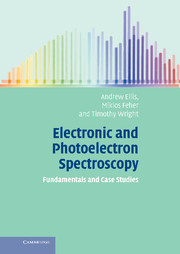Book contents
- Frontmatter
- Contents
- Preface
- List of journal abbreviations
- Part I Foundations of electronic and photoelectron spectroscopy
- Part II Experimental techniques
- 8 The sample
- 9 Broadening of spectroscopic lines
- 10 Lasers
- 11 Optical spectroscopy
- 12 Photoelectron spectroscopy
- Part III Case Studies
- Appendix A Units in spectroscopy
- Appendix B Electronic structure calculations
- Appendix C Coupling of angular momenta: electronic states
- Appendix D The principles of point group symmetry and group theory
- Appendix E More on electronic configurations and electronic states: degenerate orbitals and the Pauli principle
- Appendix F Nuclear spin statistics
- Appendix G Coupling of angular momenta: Hund's coupling cases
- Appendix H Computational simulation and analysis of rotational structure
- Index
- References
10 - Lasers
Published online by Cambridge University Press: 05 June 2012
- Frontmatter
- Contents
- Preface
- List of journal abbreviations
- Part I Foundations of electronic and photoelectron spectroscopy
- Part II Experimental techniques
- 8 The sample
- 9 Broadening of spectroscopic lines
- 10 Lasers
- 11 Optical spectroscopy
- 12 Photoelectron spectroscopy
- Part III Case Studies
- Appendix A Units in spectroscopy
- Appendix B Electronic structure calculations
- Appendix C Coupling of angular momenta: electronic states
- Appendix D The principles of point group symmetry and group theory
- Appendix E More on electronic configurations and electronic states: degenerate orbitals and the Pauli principle
- Appendix F Nuclear spin statistics
- Appendix G Coupling of angular momenta: Hund's coupling cases
- Appendix H Computational simulation and analysis of rotational structure
- Index
- References
Summary
Crucial to any spectroscopic technique is the source of radiation. It is therefore pertinent to begin the discussion of experimental techniques by reviewing available radiation sources. Although there are many different types of light sources, of which some specific examples will be given later, in many spectroscopic techniques lasers are the preferred choice. Indeed some types of spectroscopy are impossible without lasers, and so it is important to be familiar with the properties of these devices. Consequently, before describing some specific spectroscopic methods, a brief account of the underlying principles and capabilities of some of the more important types of lasers is given.
Properties
Since their discovery in 1960, lasers have become widespread in science and technology. Laser light possesses some or all of the following properties:
(i) high intensity,
(ii) low divergence,
(iii) high monochromaticity,
(iv) spatial and temporal coherence.
Each of these properties is not unique to lasers, but their combination is most easily realized in a laser. For example, a beam of light of low divergence can be obtained from a lamp by collimation via a series of small apertures, but in the process the intensity of light passing through the final aperture will be very low. On the other hand, lasers naturally produce beams of light with a low divergence and so the original intensity is not compromised.
- Type
- Chapter
- Information
- Electronic and Photoelectron SpectroscopyFundamentals and Case Studies, pp. 78 - 86Publisher: Cambridge University PressPrint publication year: 2005



